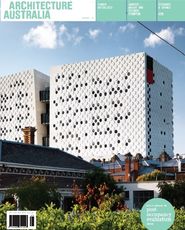
Brian Zulaikha, National President, Australian Institute of Architects.
In July, the Labor government, Greens and Independents reached a historic agreement to put Australia on a path to help limit global warming. Putting a price on carbon has not made us “early movers,” as opponents of the tax suggest. The European Union has had an ETS since 2005. And, our top five trading partners – China, Japan, the USA, South Korea and India – either have carbon trading schemes or are piloting/planning schemes. Rather than being early movers, it is more like Australia is playing catch-up.
With that said, sustainability has been a catchcry for many in our profession for a long time. But with the introduction of a carbon price and complementary measures, the impetus is there for everyone working in the built environment to use greener products and processes and to deliver more energy-efficient buildings.
Adaptive reuse may come to the fore. Rather than destroying remnants of the past and the fabric of our neighbourhoods, adaptive reuse invites new purpose. We can use our contemporary skills and understanding to improve the comfort and utility of older structures and spaces, and help reinvigorate our cities.
Reinvigorating our cities also means getting people out of their cars and onto footpaths, cycleways and into public transport. Increasing urban density and locating services and infrastructure near where people live is all part of the solution. Domestic fuel is exempt from the carbon tax – the legislation is aimed squarely at the big polluters – however, weaning us away from our cars will also make our cities more liveable and sustainable.
The Building the Education Revolution (BER) program presented an opportunity to improve the sustainability of schools throughout the country and there is no doubt the BER program helped keep our industry, and indeed the country, afloat following the global financial crisis. Projects in primary schools, in particular, delivered stimulus to every community across Australia. But there is some evidence of waste and poor management in delivering the program.
As is evidenced in the final report of the BER Implementation Taskforce released in July, there are lessons to be learnt from where the waste is concentrated. Projects in New South Wales and Victorian government schools returned the poorest quality and value-for-money outcomes. The education departments in both these states employed managing contractors to oversee the program, and template designs dominated. The report also describes a “progressive diminution of public works capacity” which has eroded governments’ capability to be “fully informed buyers.” The number of civil engineers and architects employed by state governments has halved in the last thirty years, with the result that projects are increasingly being managed by generalists rather than qualified and experienced engineers and architects.
The erosion of state government in-house capabilities did not impact BER projects in government schools in Tasmania, the ACT, Western Australia and South Australia. In these states, consultant architects were placed in managing roles and school principals and communities were empowered. Similarly, independent schools throughout the country, and most Catholic school authorities, involved principals and school communities in the BER process, working with their selected architects. Most of these schools grabbed the opportunity to build quality new facilities that integrated with their existing campuses, and often within a current masterplan. Unlike their counterparts in New South Wales and Victorian government schools they were able to deliver bespoke designs.
The BER has delivered some inspiring buildings and many of these have been recognized in our State and Territory architecture awards. The most prestigious public architecture named awards for the Northern Territory, Tasmania and South Australia went to BER projects. A number of other school projects received awards and commendations in Tasmania, South Australia, the ACT and Queensland. The report discusses the outcomes thus:
“Let’s return to the issue of environmentally sustainable design (ESD) and the lost opportunities within the BER program. There were a small percentage of projects where ESD features were seriously considered and well implemented. And, some marquee projects even garnered awards and commendations for Sustainable Architecture at their State and Territory awards. But many more projects neglected ESD or implementation was poor. The taskforce found water tanks were installed without pumps and were rarely integrated to allow recycling. Many solar panels were installed with little thought of orientation, and in other instances solar panels were removed from the scope.
“Perhaps, the biggest travesty is the retrofitting of air conditioning in buildings that were perfectly designed to utilise natural ventilation. The taskforce has recommended that prior to approval all future school buildings should be required to have a predictive-energy-use and greenhouse-gas-emissions profile that surpasses a national benchmark by at least 20%.”
We know environmental sustainability is within our reach. The Gold Creek School in the ACT, whose new environment centre was built through the BER program, has achieved a 6 Star Green Star rating. PV solar panels produce more than enough power to run the building, toilets and gardens use rainwater and grey water, and the centre is cooled passively via a thermal chimney.
Source

Archive
Published online: 20 Jan 2012
Words:
Brian Zulaikha
Issue
Architecture Australia, September 2011














